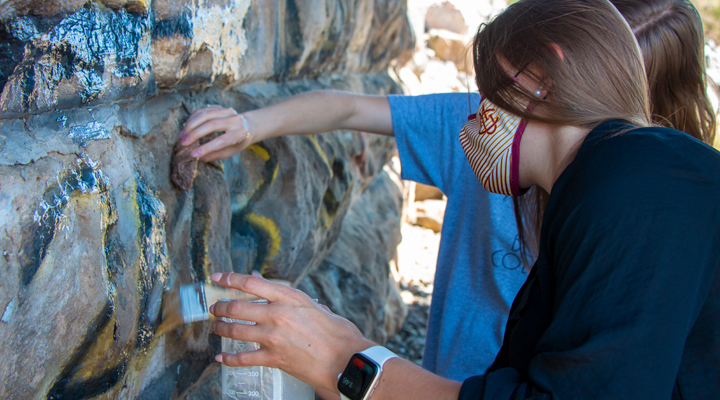Ancient rock art sparks our curiosity. Who were these people? What did they think about? Many of us ask a similar question about the people behind modern markings — graffiti, which is increasingly marring national parks and public lands. What are they thinking?
Vandalism cleanup costs American taxpayers $12 billion a year. But traditional scrubbing, sandblasting and painting methods are not effective and can even damage the rock.
Colorado Mesa University Instructor Andrew Wolff, PhD, and his chemistry team developed a starch solution that when applied at 65 degrees Celsius bonds to paint. As the solution dries and shrinks it should pull the paint off without damaging the rock surface. For a way to transport and apply the solution to graffiti in parks like the Colorado National Monument, Wolff approached CMU engineering students.
Mechanical Engineering Assistant Professor Chris Penick offered the challenge as a senior project in the collaborative CMU and University of Colorado Boulder engineering program. Students Kassidi Day, Ethan Davis, David Hale and Dylan Hallet picked up the graffiti removal Engineered Applications Device (EAD) project and got to work.
“Graffiti is rarely conveniently located next to the road,” said Day, project engineer. The team’s device had to incorporate all necessary components yet be light enough for a hiker to carry. They came up with an insulated tank that could hold one and a half gallons of starch mixture at the correct temperature for two hours, a mixing mechanism and applicator system that mounted on to a backpack frame.
But when CMU remained closed after spring break because of the COVID-19 pandemic, the team lost access to fabricating and testing resources, stalling the project. They planned to present their work at the Student Showcase, CMU’s campus-wide event highlighting student work. When the Student Showcase became a virtual event, the EAD team, like other showcase participants, switched gears to present using the online conferencing platform Zoom.
Although the EAD project was interrupted, Day said the
team’s presentation includes issues to be addressed by whoever continues their work. Penick, project faculty sponsor, said EAD could likely resurface to be resumed by another student engineering team.
Besides the interruption of a global pandemic, the EAD team also faced a real-life lesson on funding. Most student engineering projects are proposed and funded by local businesses. This project came from within CMU without funding, Penick explained, but the team applied for and won a Lockheed Martin Engineering Technology Support Grant. “It was great practice for them and quite an honor to receive the grant.”
Visit coloradomesa.edu/showcase/virtual and click on the Computer Science & Engineering Projects to find their presentation in track 4B, Engineered Applicator Device (EAD) for Biodegradable.
